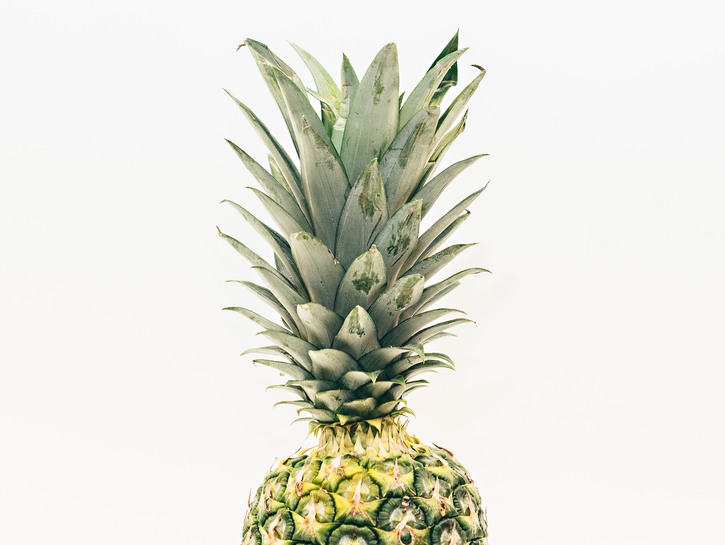Pineapples look a little menacing at first. You can’t really touch their heads and just when you think it’s safe to squeeze them you notice all the little points it has prepared for you. They might look like they’re ready to stab you at a moment’s notice, but if you push through all that then you might like to know that pineapple is a low-calorie fruit loaded with vitamin C.
If you’d like to soak in all the benefits of pineapple it’s important to learn how to tell if a pineapple is ripe. We’re here to break down the best ways to tell.
What To Avoid

A bad pineapple is going to be a dark orange in color, might show some bruising, have wilting, dry leaves, give off a poor smell, and will be mushy when you apply pressure. These are the ones to steer clear of.
On the other hand, a ripe pineapple is going to be a healthy golden yellow in color, have solid leaves, and give off a good, sweet smell from its stem.

In order to find a pineapple that’s perfect for you, you can follow the tips below and walk out of the store with a top-notch pineapple.
Smell The Stem
Pineapples, like mangos, are one of those fruits you should smell when trying to determine ripeness. Not only is this method a great way to avoid getting your hands poked, but the stem gives off a sweet, potent scent which makes it easy to tell when it’s ripe. You also won’t have to worry about distinguishing a ripe smell from an underripe smell because pineapples that aren’t ripe won’t give off any scent at all.
Take A Look At The Exterior
It should be obvious that pineapples shouldn’t have any mold growing on them, but there are some other things you can look at too.
Ripe and healthy pineapples shouldn’t be bruised or wrinkly in any spots. Pick up the pineapple when you get to the market and give it a once-over. Pineapples should be a golden-yellow in color throughout. The more yellow it is, the riper it will be. If you see pineapples that are more orange in color, you should avoid them because they’re more than likely past their prime.
Additionally, any pineapples that are purely green or brown in color should also be avoided. Some pineapples are plucked when they’re still green and it’s important to remember that once a pineapple is picked, they don’t continue to ripen. So, if you see a green pineapple in stores, it’s not going to ripen any further.
Take a look at the leaves as well. They should be green without any significant browning. If the leaves are a bit brown a bit at the top, that’s okay. But, if they’re purely withered, dried out, or darkened in color, you know they’re past their prime.

Give It A Good Squeeze
Just about every fruit out there requires that you squeeze it before buying. I know pineapples are booby-trapped with a bunch of prickles, but you still need to gently squeeze them to determine how ripe they are. If the fruit yields to gentle pressure, you have a ripe pineapple on your hands.
The distinction between a ripe and unripe pineapple isn’t as noticeable as other fruits like tomatoes or avocados, but you’ll still be able to tell the difference. Ripe pineapples will be firm but still yield a little to gentle pressure. If it’s too mushy or way too solid then you should leave that one behind.
Pluck Out One Of The Leaves
Consumers are on the fence with this tactic, but some people swear by it. If you go through the above steps but still want a little reassurance you can pluck out one of the leaves from the top.
A rule of thumb for many people is that you should be able to grab a leaf from the top and pull it out with a slight tug. Grab the pineapple with one hand and remove a leaf with the other. A gentle pull should be able to remove it, but if the leaves come out too easily then the pineapple might be starting to go bad.
Storing Your Pineapple
Once you’ve purchased your ripe pineapple you can store the entire thing at room temperature for up to three days. Keep in mind that you shouldn’t keep them at room temperature for too long because pineapples bruise easily.
If three days roll by and you haven’t eaten it yet, you can move your pineapple to the fridge. At this point, you should place your whole pineapple in a perforated bag and then stick it in the fridge. You can also peel and cut it into pieces before storing it in an airtight container in the fridge. When packaged this way, pineapple can be kept in the refrigerator for an additional two to three days.
If you’re looking to store your pieces for even longer you can keep them in an airtight container in the freezer for extra 5-6 months.

Now that you know the basics of pineapple readiness you no longer need to wonder how to tell if a pineapple is ripe. Keep an eye out for the color, smell, and leaves before taking home your perfect pineapple.
